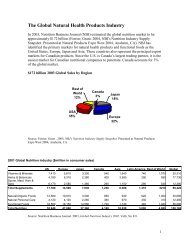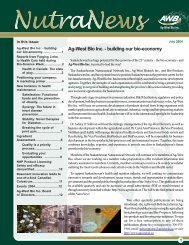Beyond Borders: Global biotechnology report 2010
Beyond Borders: Global biotechnology report 2010
Beyond Borders: Global biotechnology report 2010
You also want an ePaper? Increase the reach of your titles
YUMPU automatically turns print PDFs into web optimized ePapers that Google loves.
“Since by definition, increasing efficiency<br />
requires raising the amount of output<br />
(innovation) generated per unit of<br />
input (funding), the efficiency of capital<br />
deployment and the efficiency of drug R&D<br />
are effectively two sides of the same coin.”<br />
These approaches generally have some<br />
combination of three broad types of<br />
solutions. The first of these is lowering drug<br />
R&D costs. This is not surprising, given the<br />
tremendously capital-intensive nature of<br />
drug development. Any model that makes<br />
an appreciable dent in R&D costs could<br />
potentially make the venture investment<br />
model more efficient, by allowing VCs to<br />
fund innovation with smaller amounts of<br />
capital. Similarly, measures that increase<br />
the R&D success rate could enable a more<br />
efficient use of capital by increasing the<br />
return on investment. Lastly, there has<br />
been increasing emphasis on models that<br />
allow projects to “fail fast.” Since drug<br />
development costs increase exponentially<br />
in later stages of development, approaches<br />
that allow researchers to identify early on<br />
the ones most likely to succeed — and pull<br />
the plug on likely failures — can significantly<br />
increase the return on investment.<br />
It is worth noting that each of these<br />
potential fixes for the venture funding<br />
model is inextricably tied to the R&D<br />
process. This is not surprising, since the<br />
vast majority of funding that VCs provide is<br />
spent in research laboratories. The returns<br />
that investors earn are, in turn, directly<br />
tied to the innovations that come out of<br />
those labs (the key output of the model,<br />
as we pointed out in last year’s <strong>Beyond</strong><br />
borders). Since by definition, increasing<br />
efficiency requires raising the amount of<br />
output (innovation) generated per unit of<br />
input (funding), the efficiency of capital<br />
deployment and the efficiency of drug R&D<br />
are effectively two sides of the same coin.<br />
One approach that some investors are<br />
adopting is asset-based funding, where<br />
more early-stage venture capital is<br />
allocated to funding bare-bones research<br />
projects rather than to building full-fledged<br />
companies. Proponents of this model argue<br />
that the traditional venture funding model,<br />
with its focus on building companies, is<br />
wasteful given the very high failure rates in<br />
the early stages of R&D. In “Asset-centric<br />
financing” on page 7, Francesco De Rubertis<br />
and Michèle Ollier of Index Ventures<br />
describe their approach to asset-based<br />
funding, which allows them to take an early<br />
asset to a go/no-go point with a smaller<br />
investment than is typical in the traditional<br />
venture funding model, thereby reducing<br />
the average cost of drug development.<br />
Of course, models based on “virtual” drug<br />
development are not new — they have<br />
been tried in various forms since at least<br />
the 1990s. The fact that they have never<br />
come close to dethroning more traditional<br />
approaches to drug development testifies<br />
to the challenges associated with virtual<br />
models. For one, it is more difficult to<br />
incentivize and motivate virtual teams of<br />
service providers around a common goal.<br />
Employees at emerging biotechs often<br />
bring a high degree of passion to pursuing<br />
the company’s vision — both because of the<br />
culture of small, entrepreneurial companies<br />
6 <strong>Beyond</strong> borders <strong>Global</strong> <strong>biotechnology</strong> <strong>report</strong> <strong>2010</strong><br />
as well as incentive structures that directly tie<br />
their rewards to the company’s success. While<br />
the quality and variety of service providers<br />
has improved steadily over time, it is not clear<br />
that third parties working for a fixed fee can<br />
replicate the degree of ownership and passion<br />
that biotech companies typically get from<br />
their in-house teams.<br />
But that passion, as De Rubertis and Ollier<br />
point out, can equally be a hindrance.<br />
Management and employees at traditional<br />
biotech companies can have a greater<br />
incentive to protect the survival of the<br />
enterprise rather than make decisions<br />
purely based on R&D results. To raise<br />
the next round of financing, companies<br />
may be more inclined to design a study<br />
to demonstrate that their technology has<br />
potential or is making progress rather than<br />
expose its weakness. Instead of folding<br />
up shop after the failure of their lead R&D<br />
project, management may try to hang on<br />
by in-licensing a new R&D project, which<br />
may not always be in the best interest of<br />
investors. Instead of failing fast, biotech<br />
companies sometimes end up pursuing a<br />
lingering subsistence.<br />
Another reality of the new normal is that<br />
pharma companies are divesting assets<br />
(discussed more fully in the “Big pharma”<br />
section below), either because they are<br />
moving out of certain disease areas (e.g.,<br />
after a large merger) or because they<br />
simply don’t have the resources to pursue<br />
everything in their pipelines. Driven by<br />
this trend, we expect VCs and other<br />
investors to use more project-funding<br />
approaches for developing promising<br />
assets from these pools. These Symphony<br />
Capital-like models would involve the<br />
in-licensing of products from pharma<br />
companies and could include options<br />
that allow the companies to purchase the<br />
assets back at pre-negotiated prices if<br />
they hit certain development milestones.<br />
continued on page 8








